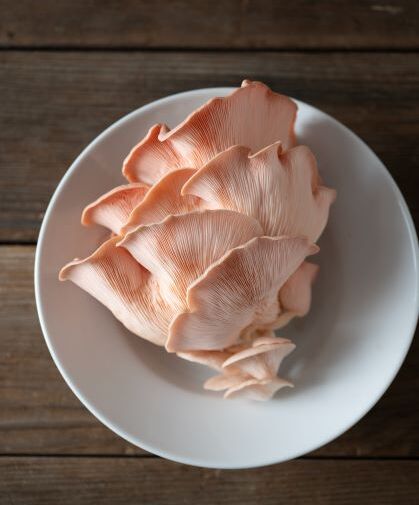Mushroom 'Spray & Grow' Kits - Key Growing Information
CULTURE:
Mushrooms require moisture, oxygen, and natural light. Choose a location that is easy to access and monitor and that has adequate air flow. Higher moisture areas such as a bathroom or kitchen are generally successful locations. If growing in an arid environment, see "Maintenance" section for recommendations. NOTE: If spore exposure is of concern, grow kits outside or in well-ventilated areas or harvest earlier before sporulation occurs.KIT STORAGE: If kits need to be stored prior to commencing growth, refrigerate or store in a cool, dry place out of direct sunlight for up to 3 months. Pink oyster kits should not be refrigerated. INITIATION:
Remove the perforated rectangle of cardboard on the face of the kit. Slice an "X" into the plastic from corner to corner to expose the substrate beneath. Fill the included mister with water and spray at least 5-10 times to achieve adequate coverage. MAINTENANCE:
Kits will need spraying at least 2-3 times a day, 5-10 sprays per visit, to maintain humidity levels. Spray more often if in a dry environment. Alternatively, create a humidity tent: create plenty of 1/2-inch ventilation holes in a plastic bag and prop over the cut face of the kit. Do not seal completely! A humidity tent will create a microenvironment by slowing the loss of moisture while still allowing oxygen to reach developing mushrooms. Spray inside of humidity tent once a day.DAYS TO MATURITY: Pins (immature mushrooms) will emerge 5-14 days after initiation. Harvest 2-5 days later, or when mushrooms are mature. A first flush is guaranteed, but it is possible to encourage 2-3 total flushes/harvests. HARVEST: Mushrooms can grow very quickly and should be checked twice daily once pins form. Increased temperatures increase growth rate further. To harvest, twist cluster off the substrate at the base. Remove excess mushrooms from kit surface to encourage another flush. Oysters: harvest when caps begin to flatten but their edges are still slightly curled over. Oysters may produce spores if allowed to grow beyond ideal maturity. If this happens, they are still harvestable, but should be harvested promptly. Overmature mushrooms will have a shorter shelf life and are more easily damaged during handling. Lion's Mane: Lion's Mane fruiting body will initially appear as a dense white form. Tooth-like structures begin to differentiate when they near maturity. Harvest when teeth are 1/4- 1/2" long and before they start to yellow. CAUTION: Ensure mushrooms are cooked thoroughly before consumption, as they contain chitin, which can be difficult to digest. If eating a species for the first time, start with a small amount to test for allergies. Do not consume moldy mushrooms. POST-HARVEST STORAGE: Relatively young mushrooms will store better. Harvest, place in paper bag, and store 3-5 days unwashed in refrigerator. MULTIPLE FLUSHES:
It is possible to encourage 'Spray & Grow' Kits to produce more than one flush by maintaining moisture levels. Continue daily sprays or consider a humidity tent. Subsequent flushes will take longer to begin pinning than the first, at about 2-3 weeks. If there is no activity after that time, remove block from box (keeping it in its bag) and soak "cut side" down in water for 20 minutes. Allow bag to drain any excess water and continue spray routine detailed above. PESTS AND DISEASE: Normal growth begins from white mycelium that can be mistaken for mold. This is normal, but mold may grow on kits damaged in transit, or those that have been growing for a long time. Do not consume moldy mushrooms. Fruit flies are attracted to mushrooms and can be trapped or deterred using repellents. Do not spray repellents directly on mushrooms!


